You are an app designer for a hotel.
The hotel wants to create an app to help the housekeeping staff schedule work.
You need to create a new environment for the app.
Where should you create the environment?
Answer:
A
Manage environment in the Power Platform admin center.
Reference:
https://docs.microsoft.com/en-us/power-platform/admin/create-environment
A company delivers products to multiple communities. The company creates a canvas app connected to a Microsoft Dataverse database. The app tracks communities to see where the delivery volume is the highest.
Drivers must enter delivery information on a form that uses an entity named Delivery. Depot staff must enter information on a pick-up form that uses an entity named Pick-up. Each form contains a community field that is based on a shared list across both forms.
You need to create the community field.
Which type of field should you create?
Answer:
C
Can use a global option set, no need to use localized option sets.
Note: In PowerApps Option set is one of the field types you can use in your Entity. The information type that Option Set stores is a list of text values. And here comes the Option Set advantage ג€" once you define its text values you can centrally managed it.
Reference:
https://powerapps.microsoft.com/en-us/blog/option-sets-and-many-to-many-relationships-for-canvas-apps/
A company has an on-premises system that stores product information. The company plans to replace the information with a Power Platform solution that uses the
Common Data Service.
The Power Platform solution needs to use data from the product information system.
You need to transform and import the data from the product information system.
Which two tools should you use? Each correct answer presents part of the solution.
NOTE: Each correct selection is worth one point.
Answer:
AD
The on-premises data gateway acts as a bridge to provide quick and secure data transfer between on-premises data (data that isn't in the cloud) and several
Microsoft cloud services. These cloud services include Power BI, PowerApps, Power Automate, Azure Analysis Services, and Azure Logic Apps. By using a gateway, organizations can keep databases and other data sources on their on-premises networks, yet securely use that on-premises data in cloud services.
Can use the Power Platform dataflows to load entity in CDS with the option to transform data.
Reference:
https://docs.microsoft.com/en-us/power-bi/connect-data/service-gateway-onprem https://nishantrana.me/2020/07/07/load-data-from-sql-on-premise-to-cds-common-data-service-using-power-platform-dataflows-in-power-apps/
DRAG DROP -
You are creating entities in a Microsoft Dataverse database to capture sales data.
You create an entity named Sales that includes the following fields:
You create a new entity that includes a field named TotalSales. The field is used to capture the aggregated sales for each salesperson.
You need to configure the fields for the entities.
Which field types should you use? To answer, drag the appropriate field types to the correct field names. Each field type may be used once, more than once, or not at all. You may need to drag the split bar between panes or scroll to view content.
NOTE: Each correct selection is worth one point.
Select and Place: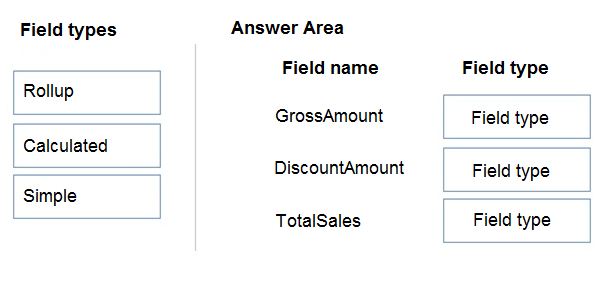
Answer:
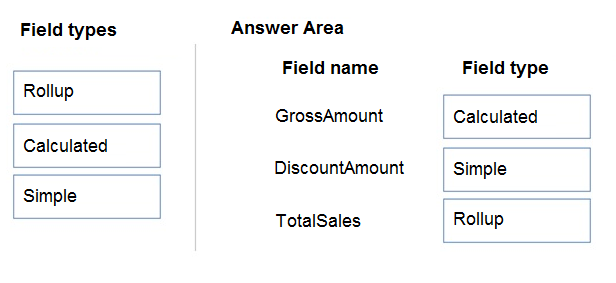
Box 1: Calculated -
Calculated columns are calculated in real-time when they are retrieved. Calculated columns can be composed using different data types. For example, an Integer calculated column may reference values from Decimal or Currency columns.
Box 2: Simple -
A simple column isn't defined as a calculated or rollup column.
Box 3: Rollup -
Because rollup columns persist in the database, they can be used for filtering or sorting just like regular columns.
Reference:
https://docs.microsoft.com/en-us/powerapps/developer/data-platform/calculated-rollup-attributes
In a Microsoft Dataverse database, you create a canvas app and a custom entity. The app also reads data from the Account entity in the Microsoft Dataverse database.
Entity access permissions will be controlled by the Microsoft Dataverse User security role. You create a Microsoft Dataverse Service solution.
You need to replicate the changes to a new Microsoft Dataverse database.
Which two components should you include with the canvas app? Each correct answer presents part of the solution.
NOTE: Each correct selection is worth one point.
Answer:
BC
HOTSPOT -
You need to create a model-driven app without using code.
Which tools should you use? To answer, select the appropriate options in the answer area.
NOTE: Each correct selection is worth one point.
Hot Area: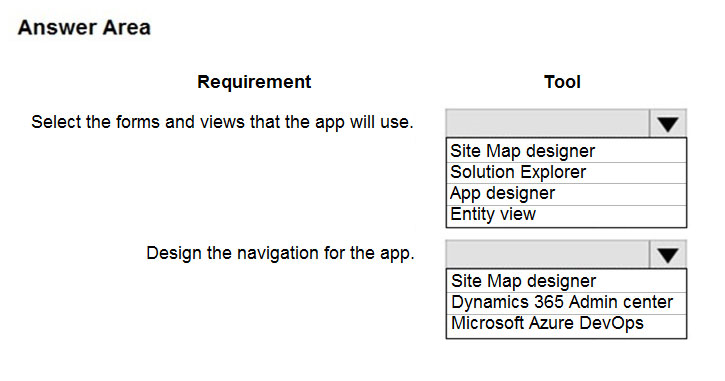
Answer:
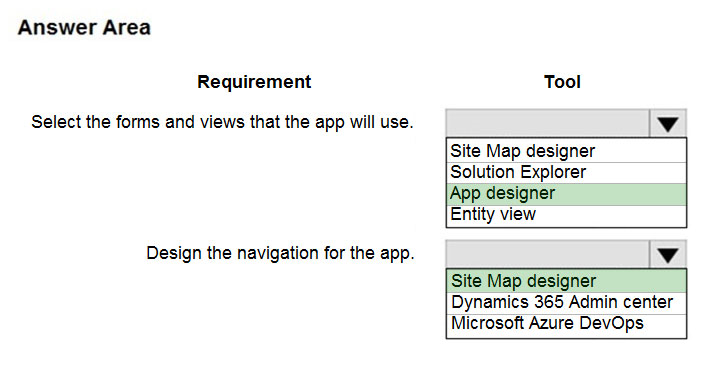
Box 1: App designer -
As an app maker, you can create and edit public views by using Power Apps.
Box 2: Site Map designer -
Site maps define the navigation for your app. Create a site map for your app with ease by using the tile-based site map designer.
Reference:
https://docs.microsoft.com/en-us/powerapps/maker/model-driven-apps/create-edit-views-app-designer https://docs.microsoft.com/en-us/powerapps/maker/model-driven-apps/create-site-map-app
HOTSPOT -
You are creating a capacity planning dashboard with Power BI desktop.
The dashboard must be able to be used within a model-driven manufacturing planning app as well as be embedded within a Microsoft Teams channel.
The data sources are as follows:
You need to determine the appropriate method for accomplishing each task.
Which methods should you use? To answer, select the appropriate options in the answer area.
NOTE: Each correct selection is worth one point.
Hot Area: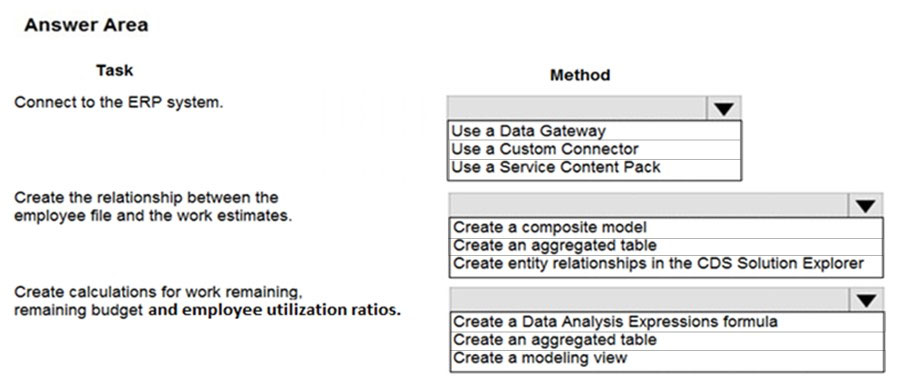
Answer:
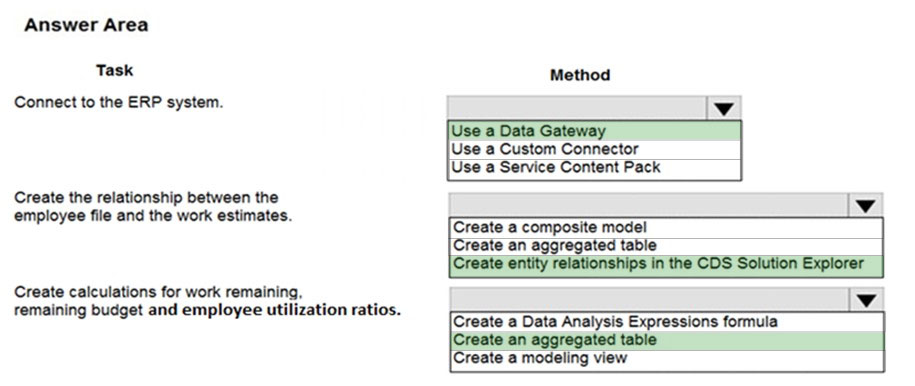
Box 1: Use a Date Gateway -
You can install an on-premises data gateway on the same local computer as SQL Server (in production, it would typically be a different computer).
Box 2: Create an entity relationship in CDS Solution Explorer
You can create relationships with CDS Solution Explorer.
Box 3: Create an aggregate table
Rollup columns help users obtain insights into data by monitoring key business metrics. A rollup column contains an aggregate value computed over the rows related to a specified row. This includes regular tables and activity tables such as emails and appointments.
Incorrect Answers:
✑ Data Analysis Expressions (DAX) is a library of functions and operators that can be combined to build formulas and expressions in Power BI, Analysis
Services, and Power Pivot in Excel data models.
✑ With Modeling view in Power BI Desktop, you can view and work with complex datasets that contain many tables.
Reference:
https://docs.microsoft.com/en-us/power-bi/connect-data/service-gateway-sql-tutorial https://docs.microsoft.com/en-us/powerapps/maker/data-platform/create-edit-entity-relationships https://docs.microsoft.com/en-us/powerapps/maker/data-platform/define-rollup-fields
Note: This question is part of a series of questions that present the same scenario. Each question in the series contains a unique solution that might meet the stated goals. Some question sets might have more than one correct solution, while others might not have a correct solution.
After you answer a question in this section, you will NOT be able to return to it. As a result, these questions will not appear in the review screen.
You build a canvas app for a manufacturing company. The company receives parts and materials from many vendors. You create a form to collect information from packing slips.
Receivers must be able to take a picture of packing slips to receive materials instead of manually entering data in the app.
You need to ensure that users can scan packing slip information into the form.
Proposed solution: Use a Text Recognition model.
Does the solution meet the goal?
Answer:
A
Create a canvas app and add the text recognizer AI Builder component to your screen. This component takes a photo or loads an image from the local device, and then processes it to detect and extract text based on the text recognition prebuilt model. If it detects text in the image, the component outputs the text and identifies the instances by showing a rectangle for each instance in the image.
Reference:
https://docs.microsoft.com/en-us/ai-builder/prebuilt-text-recognizer-component-in-powerapps
HOTSPOT -
Rangers in national parks report wildlife they encounter during patrols. The rangers record observations in a notebook when they are on patrol. The rangers manually enter observation data when they are in the office. You are designing an app that allows rangers to record their observations while they are on patrol.
The wildlife is modeled as a custom table named Wildlife. The model has relationships to the annotation entity and to a custom entity named Wildlife Details. In the
Wildlife Details entity, rangers capture more information as they observe an animal's habitat. When observing wildlife, rangers must indicate whether an animal requires medical attention. The app must synchronize and save data to Common Data Service when connectivity is available.
You need to design the app.
What should you do? To answer, select the appropriate options in the answer area.
NOTE: Each correct selection is worth one point.
Hot Area: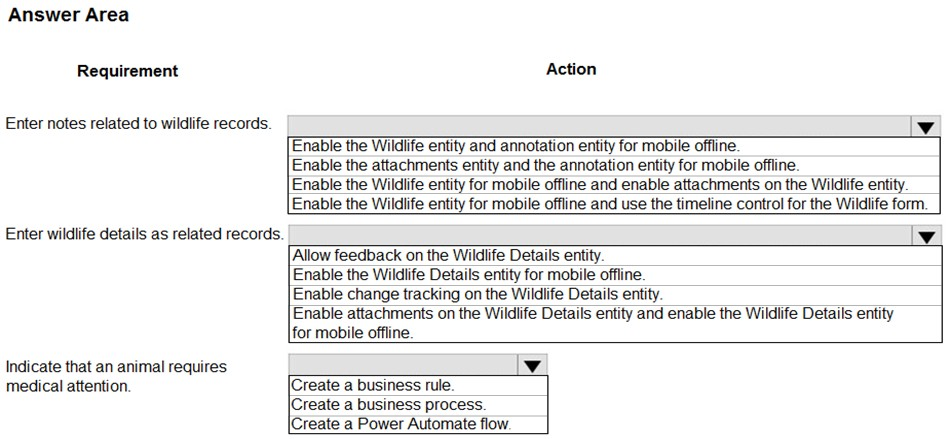
Answer:
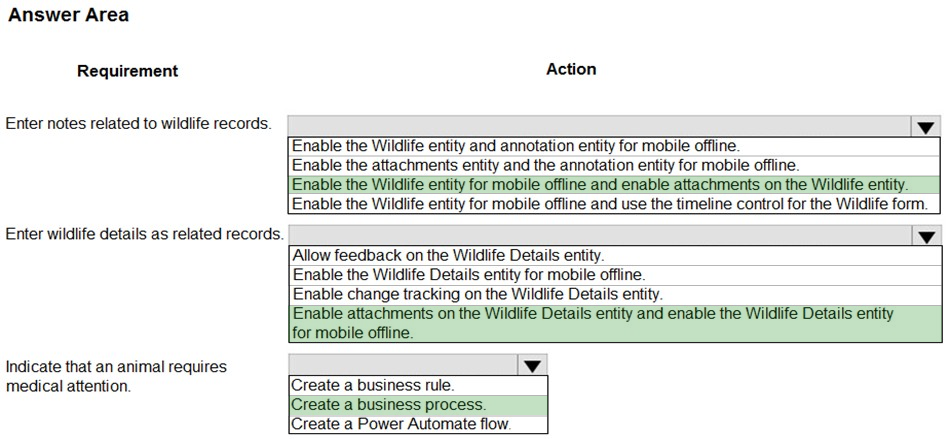
Box 1: Enable the Wildlife entity and the annotation entity for mobile offline
Note: As part of the 2020 Wave 2 release, we made generally available offline capabilities for model driven apps for users of Power Apps. Makers and administrators can now configure apps to be available offline on a user's device, and users can continue to complete their tasks against the local cache on their phone even with intermittent or no network connectivity. When the network is re-established, the users' changes are seamlessly synchronized back to the cloud.
Box 2: Enable attachments on the Wildlife Details entity and enable Wildlife Details entity for mobile offline.
Box 3: Create a business process.
Business process flows. Ensure that people enter data consistently and follow the same steps every time they work in an app by creating a business process flow.
Note: Power Automate includes several types of processes, each designed for a different purpose:
✑ Automated flows. Create a flow that performs one or more tasks automatically after it's triggered by an event.
✑ Button flows.
✑ Scheduled flows. Create a flow that performs one or more tasks on a schedule such as once a day, on a specific date, or after a certain time.
✑ Business process flows. Ensure that people enter data consistently and follow the same steps every time they work in an app by creating a business process flow.
Workflows and actions. Dynamics 365 customizers may be familiar with the classic Microsoft Dataverse processes, which are workflows and actions.
Reference:
https://powerapps.microsoft.com/en-us/blog/mobile-offline-for-power-apps/ https://docs.microsoft.com/en-us/powerapps/maker/model-driven-apps/guide-staff-through-common-tasks-processes
A company plans to roll out several Power Apps apps to multiple business units across international operations.
The apps must be managed through an application lifecycle management (ALM) solution to provide a consistent and predictable use experience. All changes to the app must be traceable and documented in a single location. You must be able to revert to a previous version of an app. The app release cycles must be as streamlined as possible.
You need to create an application for the apps.
Which two tools should you use? Each correct answer presents part of the solution.
NOTE: Each correct selection is worth one point.
Answer:
AD
A: DevOps is the combining of two historically disparate disciplines: software development and IT operations. The primary goal of DevOps is to shorten the software development lifecycle and provide continuous integration and continuous delivery (CI/CD) with high software quality. You can use Power Apps build tools to automate common build and deployment tasks related to Power Apps if your DevOps platform is Azure DevOps.
D: Microsoft AppSource is now embedded in the Dynamics 365 home page and throughout the common navigation. It now includes a private gallery of apps available to you within your company. Select Get more apps from the home page or task pane, and navigate to the My Organization tab to see apps that are available to you.
Reference:
https://docs.microsoft.com/en-us/power-platform/alm/devops-build-tools https://docs.microsoft.com/en-us/powerapps/user/app-source